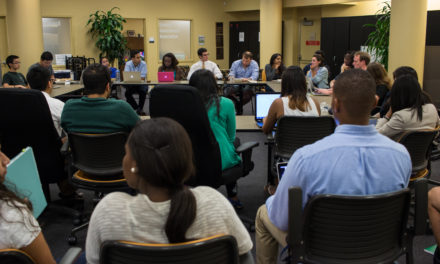For more than a year, the University has been conceptualizing and analyzing the renovation and replacement of the Dobbs University Center (DUC).
This project, still early in its development, would potentially involve demolishing the DUC’s west wing (which includes Dobbs Market, Eagle’s Landing, Mail Services and Eagle Convenience) and renovating the historic east wing, according to the new center’s feasibility study, a standard work compiling feedback about the current DUC and what a new center should entail from the Emory community.
The feasibility study also recommends the creation of a 1,600-person (or undergraduate class-sized) multipurpose space, increasing retail food options available in the DUC, expanding the center’s accessibility to those with disabilities and making the center more approachable for all Emory students, among other recommendations. These recommendations will not necessarily be implemented, but the study will provide concrete parameters and identify needs for the new center.
We at the Wheel applaud the University for identifying this needed project, and we applaud the Emory community for accurately recognizing several aspects that should provide the foundation of this project’s design.
[quote_box name=””]We agree with much of the study’s assessment of the current deficiencies in the DUC. Today, the DUC is mostly a place for freshmen and some sophomores to eat and for student offices, which should not be the whole extent of a student union.[/quote_box]
The feasibility study projects a total cost of $98 million for the new center, a figure that could change significantly throughout the process. The University has just renovated its Mail Services and established a new convenience store in the wing of the DUC that will potentially be demolished, but we understand that these improvements were made with a new center in mind. While the cost makes our jaws drop, we hope the University uses that money judiciously.
The feasibility study emphasizes sustainability as one of the key drivers in the new center, where the renovations for the new center would include upgrades to the historic DUC’s mechanical systems, insulation and other energy sources. Emory’s commitment to sustainability sets us apart from other universities, and we commend this recommendation and encourage the University to take this commitment to the forefront of the new center.
In addition, if the University does decide to gut and renovate the historic east wing of the DUC, that renovation should be severe and unflinching. While the original building (which houses the Mary Gray Munroe Theater) and the rest of the east wing, named the Alumni Memorial Building and completed around 1950, has aesthetic and historical value, many of its spaces are out-of-date for the needs of modern college students, and its design (including a dysfunctional elevator and too-few bathrooms) needs an extreme makeover. If these recommendations come to fruition, we hope the University drastically changes the layout of the east wing, which is difficult for new (and old) community members to navigate and where student media groups are unnecessarily hidden away on the fifth floor. On the other hand, if these groups were moved to the main floor or another more approachable side of the center, this would increase accessibility and visibility for these organizations.
We agree with much of the study’s assessment of the current deficiencies in the DUC. Today, the DUC is mostly a place for freshmen and some sophomores to eat and for student offices, which should not be the whole extent of a student union. The study aims to make the new center more approachable and useful to upperclassmen, graduate students and other Emory community members, and we feel this should be a powerful idea in the new center’s design.
In addition, the study aims to improve several shortcomings in the DUC’s current accessibility to those with disabilities. A weakness for much of Emory’s campus, handicapped accessibility in the DUC is severely lacking, specifically in the east wing’s hallways and other points of entry. A University student union, such as the DUC, should be where all students on campus, regardless of age or ability, can congregate or study — what the study calls the “living room of campus.”
The current DUC does not suit these needs. Specifically, the DUC currently does not offer enough small meeting spaces for its students. The current main options for meetings are Eagle’s Landing or Coke Commons, where students often have to shout to be heard in atriums with terrible acoustics. Like the study correctly recommends, the new center should be designed with the many organizations of its University in mind. Currently, scheduling meetings at spaces like Harland Cinema becomes an unwarranted hassle, and the University should consolidate unused rooms or shoebox offices during the east wing’s renovations to better house these types of meetings.
Additionally, while Emory’s several libraries are the study hotspots on campus, the new center should also seek to provide more open study areas on its main floors, similar to the new renovations on the main floor of the Woodruff Library. If the center truly seeks to be a “living room” for campus, it should aim to provide flexible, multi-purpose spaces.
Finally, the idea of a large event space would be an important addition to our campus. Currently, venues for large events tend to be outside, such as on McDonough Field or the Goizueta Business School Amphitheatre, which make events at the mercy of often unpredictable weather. This forces many student organizations to plan events in venues that may be too small, such as Winship Ballroom or fraternity houses. If the new center contains a multipurpose, large event space, which could be partitioned off, this would provide a new option for student organizations (and the University, with events like Commencement) to host events in a neutral space.
Overall, we at the Wheel are excited and hopeful about what a new student center can provide for Emory, and we are encouraged by the recommendations from the feasibility study, which seem to be pointing the design of the new center in the right direction. As the design and construction of the project is set to begin in the coming years, we are eager to see the University implement these recommendations.
The above staff editorial represents the majority opinion of the Wheel’s editorial board.
The Emory Wheel was founded in 1919 and is currently the only independent, student-run newspaper of Emory University. The Wheel publishes weekly on Wednesdays during the academic year, except during University holidays and scheduled publication intermissions.
The Wheel is financially and editorially independent from the University. All of its content is generated by the Wheel’s more than 100 student staff members and contributing writers, and its printing costs are covered by profits from self-generated advertising sales.







